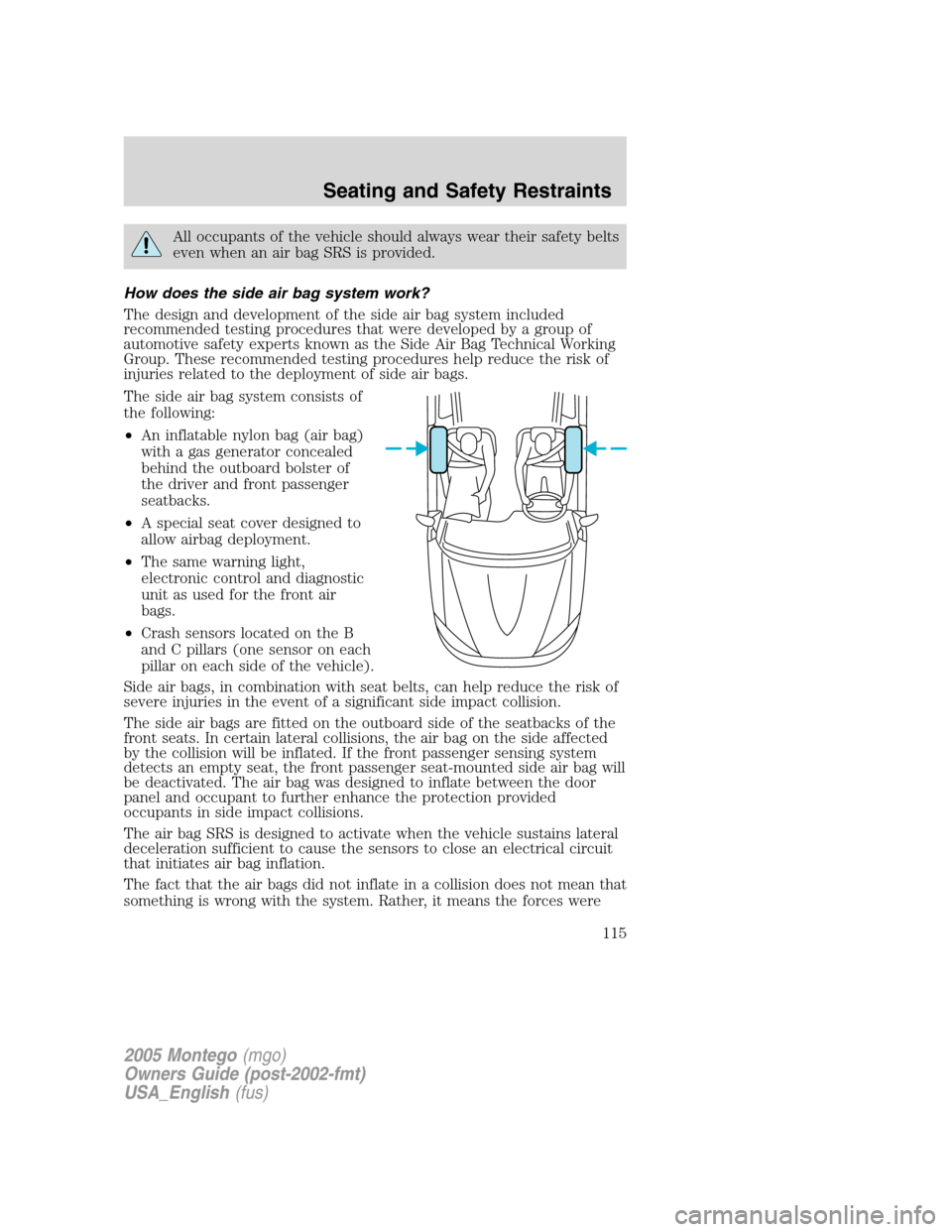Page 115 of 264

All occupants of the vehicle should always wear their safety belts
even when an air bag SRS is provided.
How does the side air bag system work?
The design and development of the side air bag system included
recommended testing procedures that were developed by a group of
automotive safety experts known as the Side Air Bag Technical Working
Group. These recommended testing procedures help reduce the risk of
injuries related to the deployment of side air bags.
The side air bag system consists of
the following:
•An inflatable nylon bag (air bag)
with a gas generator concealed
behind the outboard bolster of
the driver and front passenger
seatbacks.
•A special seat cover designed to
allow airbag deployment.
•The same warning light,
electronic control and diagnostic
unit as used for the front air
bags.
•Crash sensors located on the B
and C pillars (one sensor on each
pillar on each side of the vehicle).
Side air bags, in combination with seat belts, can help reduce the risk of
severe injuries in the event of a significant side impact collision.
The side air bags are fitted on the outboard side of the seatbacks of the
front seats. In certain lateral collisions, the air bag on the side affected
by the collision will be inflated. If the front passenger sensing system
detects an empty seat, the front passenger seat-mounted side air bag will
be deactivated. The air bag was designed to inflate between the door
panel and occupant to further enhance the protection provided
occupants in side impact collisions.
The air bag SRS is designed to activate when the vehicle sustains lateral
deceleration sufficient to cause the sensors to close an electrical circuit
that initiates air bag inflation.
The fact that the air bags did not inflate in a collision does not mean that
something is wrong with the system. Rather, it means the forces were
2005 Montego(mgo)
Owners Guide (post-2002-fmt)
USA_English(fus)
Seating and Safety Restraints
115
Page 117 of 264

All occupants of the vehicle including the driver should always
wear their safety belts even when an air bag SRS and Safety
Canopy�system is provided.
To reduce risk of injury, do not obstruct or place objects in the
deployment path of the inflatable Safety Canopy�.
How does the Safety Canopy�system work?
The design and development of the
Safety Canopy�system included
recommended testing procedures
that were developed by a group of
automotive safety experts known as
the Side Air Bag Technical Working
Group. These recommended testing
procedures help reduce the risk of
injuries related to the deployment of
side airbags (including the Safety
Canopy�).
The Safety Canopy�system
consists of the following:
•An inflatable nylon curtain with a
gas generator concealed behind
the headliner and above the doors
(one on each side of vehicle).
•A headliner designed to flex open
above the side doors to allow Safety Canopy�deployment.
•The same readiness airbag light, electronic control and diagnostic unit
as used for the front airbags.
•Two crash sensors mounted on the B pillar (one on each side of the
vehicle).
•Two crash sensors located at the C pillar behind the rear doors (one
on each side of the vehicle).
•Rollover sensor in the restraints control module (RCM).
The Safety Canopy�system, in combination with seat belts, can help
reduce the risk of severe injuries in the event of a significant side impact
collision or rollover event.
2005 Montego(mgo)
Owners Guide (post-2002-fmt)
USA_English(fus)
Seating and Safety Restraints
117
Page 119 of 264

Determining if the system is operational
The SRS uses a readiness light in the instrument cluster or a tone to
indicate the condition of the system. Refer to theAir bag readiness
section in theInstrument Clusterchapter. Routine maintenance of the
air bag is not required.
Any difficulty with the system is indicated by one or more of the
following:
•The readiness airbag light (same light as for front air bag system) will
either flash or stay lit.
•The readiness light will not illuminate immediately after ignition is
turned on.
•A series of five beeps will be heard. The tone pattern will repeat
periodically until the problem and light are repaired.
If any of these things happen, even intermittently, have the SRS serviced
at your dealership or by a qualified technician immediately. Unless
serviced, the system may not function properly in the event of a collision
or rollover event.
Disposal of air bags and air bag equipped vehicles
For disposal of air bags or air bag equipped vehicles, see your local
dealership or qualified technician. Air bags MUST BE disposed of by
qualified personnel.
SAFETY RESTRAINTS FOR CHILDREN
See the following sections for directions on how to properly use safety
restraints for children. Also seeAir bag supplemental restraint system
(SRS)in this chapter for special instructions about using air bags.
Important child restraint precautions
You are required by law to use safety restraints for children in the U.S.
and Canada. If small children (generally children who are four years old
or younger and who weigh 40 lb. [18 kg] or less) ride in your vehicle, you
must put them in safety seats made especially for children. Many states
require that children use approved booster seats until they are eight
years old. Check your local and state or provincial laws for specific
requirements regarding the safety of children in your vehicle. When
possible, always place children under age 12 in the rear seat of your
vehicle. Accident statistics suggest that children are safer when properly
restrained in the rear seating positions than in the front seating position.
2005 Montego(mgo)
Owners Guide (post-2002-fmt)
USA_English(fus)
Seating and Safety Restraints
119